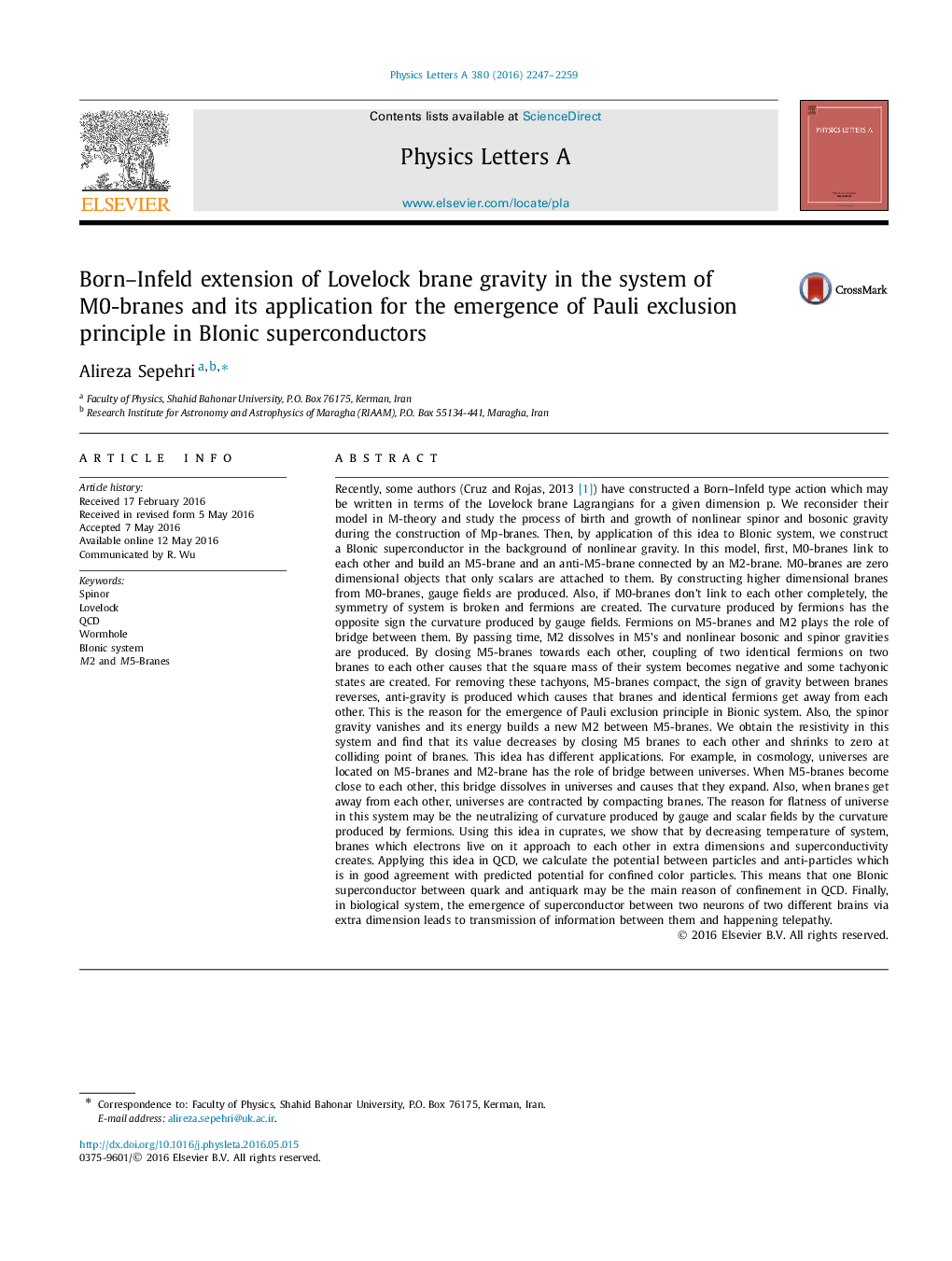| کد مقاله | کد نشریه | سال انتشار | مقاله انگلیسی | نسخه تمام متن |
|---|---|---|---|---|
| 1863191 | 1530548 | 2016 | 13 صفحه PDF | دانلود رایگان |

• We show that by breaking of symmetry of Mp-branes, fermions are created.
• We find the origin of Pauli exclusion principle in M-theory.
• We introduce Bionic Superconductor for the first time.
• Our model can explain the origin of confinement between quark–anti-quark in QCD.
• Our model confirms the telepathy between two brains of two humans in Biology.
Recently, some authors (Cruz and Rojas, 2013 [1]) have constructed a Born–Infeld type action which may be written in terms of the Lovelock brane Lagrangians for a given dimension p. We reconsider their model in M-theory and study the process of birth and growth of nonlinear spinor and bosonic gravity during the construction of Mp-branes. Then, by application of this idea to BIonic system, we construct a BIonic superconductor in the background of nonlinear gravity. In this model, first, M0-branes link to each other and build an M5-brane and an anti-M5-brane connected by an M2-brane. M0-branes are zero dimensional objects that only scalars are attached to them. By constructing higher dimensional branes from M0-branes, gauge fields are produced. Also, if M0-branes don't link to each other completely, the symmetry of system is broken and fermions are created. The curvature produced by fermions has the opposite sign the curvature produced by gauge fields. Fermions on M5-branes and M2 plays the role of bridge between them. By passing time, M2 dissolves in M5's and nonlinear bosonic and spinor gravities are produced. By closing M5-branes towards each other, coupling of two identical fermions on two branes to each other causes that the square mass of their system becomes negative and some tachyonic states are created. For removing these tachyons, M5-branes compact, the sign of gravity between branes reverses, anti-gravity is produced which causes that branes and identical fermions get away from each other. This is the reason for the emergence of Pauli exclusion principle in Bionic system. Also, the spinor gravity vanishes and its energy builds a new M2 between M5-branes. We obtain the resistivity in this system and find that its value decreases by closing M5 branes to each other and shrinks to zero at colliding point of branes. This idea has different applications. For example, in cosmology, universes are located on M5-branes and M2-brane has the role of bridge between universes. When M5-branes become close to each other, this bridge dissolves in universes and causes that they expand. Also, when branes get away from each other, universes are contracted by compacting branes. The reason for flatness of universe in this system may be the neutralizing of curvature produced by gauge and scalar fields by the curvature produced by fermions. Using this idea in cuprates, we show that by decreasing temperature of system, branes which electrons live on it approach to each other in extra dimensions and superconductivity creates. Applying this idea in QCD, we calculate the potential between particles and anti-particles which is in good agreement with predicted potential for confined color particles. This means that one BIonic superconductor between quark and antiquark may be the main reason of confinement in QCD. Finally, in biological system, the emergence of superconductor between two neurons of two different brains via extra dimension leads to transmission of information between them and happening telepathy.
Journal: Physics Letters A - Volume 380, Issues 29–30, 1 July 2016, Pages 2247–2259